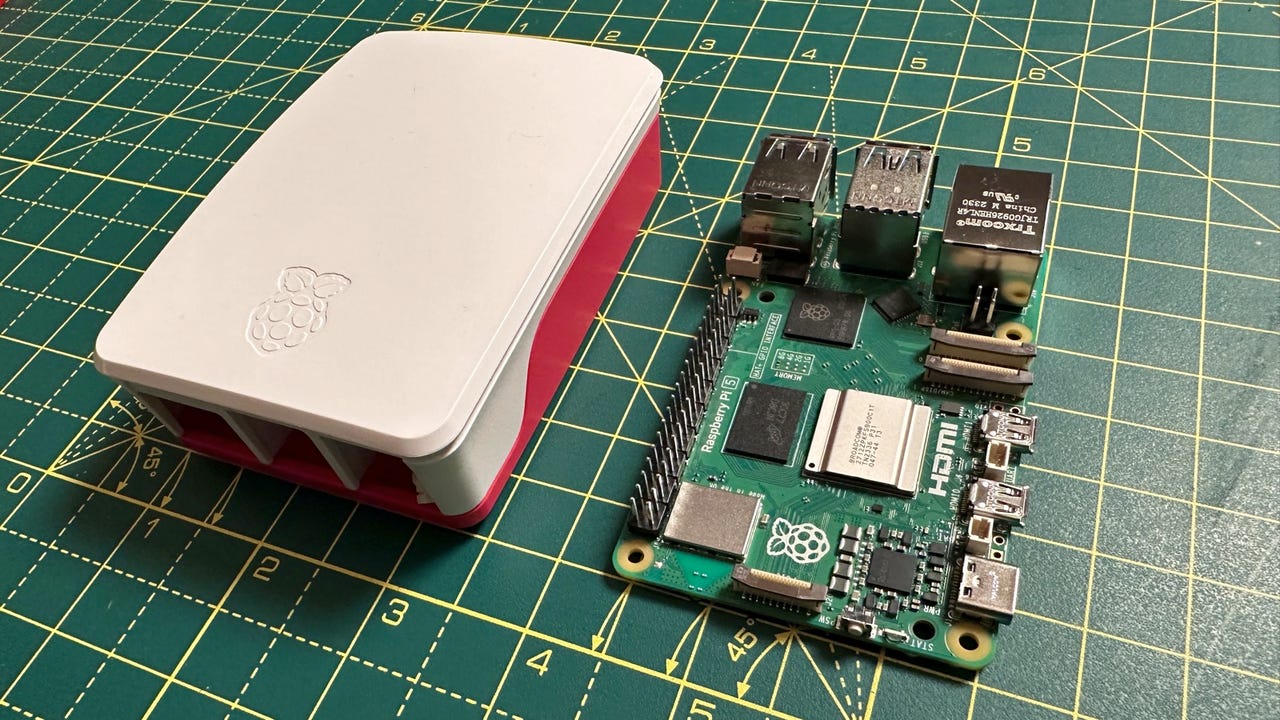
































Raspberry Pi 5 alongside the official case.
Adrian Kingsley-Hughes/I love the Raspberry Pi 5 Active Cooler -- I think it's the best way to keep theRaspberry Pi 5 running super cool, no matter what the load on the board.
But after I tested the cooler, several of you had a question relating to the official Raspberry Pi 5 case and whether that would be enough to keep an overclocked Raspberry Pi 5 cool.
Also: The Raspberry Pi 5 cracks passwords twice as fast as my Pi 4, but there's one issue
I have a Raspberry Pi 5, a variety of parts, and time on my hands. What's more, I'm willing to risk sacrificing a Raspberry Pi 5 in the name of science.
So, I took a Raspberry Pi 5 and the official case. This case has a built-in fan, and a stick-on heatsink that goes on top of the processor of the Raspberry Pi 5. Finding thiscase is about as difficult as finding a Raspberry Pi 5, which is hopefully a situation that improves soon.
Note: If you want to know how to overclock a Raspberry Pi 5, you can find that informationhere.
OK, I've managed to get my hands on the official case, so let's take a look at how good it is.
Everything that comes with the official Raspberry Pi 5 case, and a Raspberry Pi 5.
Adrian Kingsley-Hughes/Fitting the Raspberry Pi into the case is easy.
First, find the heatsink, remove the self-adhesive backing, and stick this part on top of the processor on the Raspberry Pi 5.
The heatsink.
Adrian Kingsley-Hughes/Heatsink stuck on the processor on the Raspberry Pi 5.
Adrian Kingsley-Hughes/At this stage, I recommend removing the little plastic cover that lives over the fan connector.
Also: Finding Raspberry Pi: Where to buy the latest model and its alternatives
Removing it after you've fitted the board into the case is tricky and you usually end up having to remove the board (so, don't make the mistake I made).
Remove the cover over the fan connector.
Adrian Kingsley-Hughes/Then, slide the board into the case. The board is held in place beneath little tabs. You'll know when you have it seated right because the screw holes in the Raspberry Pi 5 line up with the screw holes in the bottom of the case.
Slide the Raspberry Pi 5 into the case.
Adrian Kingsley-Hughes/The next step is to wire up the fan to the board. The connector will only fit one way (yellow wire nearest the edge of the board).
Fitting the fan connector.
Adrian Kingsley-Hughes/Next, clip the top cover in place. It slots into a lug in the case opposite the ports on the Raspberry Pi 5.
Clip the fan cover in place.
Adrian Kingsley-Hughes/There are a few things you'll have to do to finish up, such as popping the white top cover in place, and sticking the rubber feet onto the bottom of the case (they not only help prevent it from sliding around, but also help reduce noise and vibration), and pushing an imaged microSD card into the slot (yes, there's a slot in the case for it).
Installing the microSD card.
Adrian Kingsley-Hughes/Now, all that's left to do is plug the Raspberry Pi 5 into power and fire it up.
It works!
Adrian Kingsley-Hughes/Now, I wouldn't run an overclocked Raspberry Pi 5 without decent cooling because it's either going to be very unhappy or suffer an untimely demise. I've tested the Active Cooler and found that tool to be excellent at keeping the Raspberry Pi 5 cool.
But what about the official case? It has a fan and heatsink, so will that work?
With the Active Cooler and Raspberry Pi 5, and then running the Hashcat password-cracking tool in benchmark mode, I couldn't get the temperatures to exceed 55oC (131oF). Without the Active Cooler, Hashcat would have pushed the temperatures up to 71oC (160oF).
Also: How to set up your first Raspberry Pi
So, what about running the same test with the official case and heatsink? Under these conditions, I pushed the temperatures up to 80oC (176oF), which is hot, but not warm enough to throttle the processor, so it's certainly good enough, which is impressive.
I did discover that if you unclip the fan frame from the top cover and omit the clip on the top, a Raspberry Pi 5 kitted out with an Active Cooler will fit into the case. In order to protect the fan from fingers and things falling into the case, I fitted asimple plexiglas top cover that I picked up from a UK outlet.
What's more, my solution looks pretty good.
I think my workaround gives you the best of all worlds.
 Hot Tags :
Our process
Home & Office
Hot Tags :
Our process
Home & Office